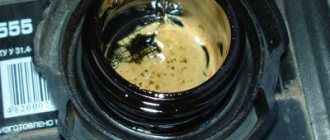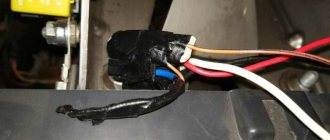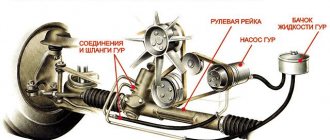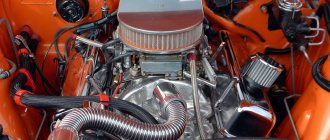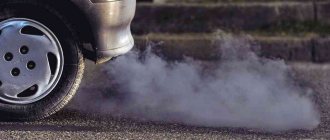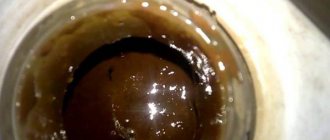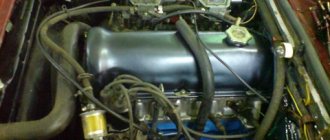Checking the MM level in the engine is a routine operation performed almost daily. As a rule, drivers limit themselves to checking whether the level has dropped below the minimum mark, not paying too much attention to the color of the liquid and its consistency, although this can tell about many processes occurring in the power unit.
In particular, the presence of tiny metal shavings on the dipstick, which give off a characteristic shine, indicates that the oil is not coping with the task of minimizing friction of engine parts, and the cause of this phenomenon should be sought. Darkening of the oil is evidence of its contamination and the need to replace the technical fluid.
But the appearance of a white emulsion on the dipstick rarely goes unnoticed. Unfortunately, a significant part of the huge army of motorists only approximately and often very superficially understands what this means and what it threatens. We bring to your attention a small educational program on this topic.
Reasons for the formation of emulsion
Pure oil, despite the presence of a certain number of additives and impurities, is not inclined to form foamed inhomogeneities. This feature manifests itself when water gets into the lubricant. How it penetrates into the lubrication system, which is, in principle, autonomous and sealed, we will now consider.
The main reasons for the appearance of emulsion in engine oil:
- loss of tightness of the BC head gasket (burnout, breakdown or other damage);
- deformation of the plane of interface of the head with the BC, as a result of which loss of tightness of the connection occurs;
- the appearance of a crack in the cylinder head/cylinder head housing;
- accumulation of condensate in the crankcase;
- moisture entering the crankcase directly from the cylinders.
It is clear that water does not have even a hundredth of the lubricating properties characteristic of motor oil, so its entry into the technical fluid inevitably leads to a deterioration in its performance characteristics. A decrease in lubrication quality leads to increased friction and faster wear of power unit parts. At ambient temperatures, the mixture of oil and water will be relatively homogeneous, but at high temperatures, typical of a warm engine, foaming of the water occurs. And it is by the presence of such a yellow or whitish emulsion on the dipstick that one can determine that the tightness of the lubrication system is most likely broken.
In conditions of negative temperatures when the car is parked for a long time, water, unlike MM, freezes, creating obstacles to the normal circulation of oil along the lines. Foaming of the lubricant, which begins at medium speeds and occurs most intensely at high speeds, leads to a decrease in oil drop in the system. As a result, the engine begins to experience oil starvation, the most unfavorable consequence of which is engine jamming.
If moisture enters the crankcase from the space above the piston, this means that it accumulates there, increasing the risk of water hammer - this usually happens when the power unit is started.
The penetration of coolant into the MM can be indirectly judged by the decrease in the level of antifreeze/antifreeze. It is quite easy to check this by simply unscrewing the cap of the expansion tank and making sure that the coolant level has dropped. The check should be carried out with the engine cooled down. If there are no visible reasons for the drop in antifreeze level (in the form of leaks and wet spots under the bottom), then most likely this was due to a violation of the integrity of the cylinder head gasket or the block itself.
According to statistics, it is the gasket that is the most common reason for the dilution of engine oil with coolant, consisting of water itself and a chemical reagent.
Loss of gasket integrity occurs either due to engine overheating or due to its natural wear and tear. Therefore, every case of overheating of the power unit should not be ignored, and first of all you need to check the condition of the lubricating fluid.
But even without overheating, the gasket can become leaky, since it is exposed to the high temperatures and pressures characteristic of the combustion chamber. Typically, its service life is about 100 thousand kilometers, after which it is subject to routine replacement. However, it is recommended to perform this operation after each dismantling of the head. If the gasket is broken, the power unit will operate unstably, and the coolant level will constantly decrease.
Simply replacing the gasket to eliminate the loss of tightness between the head and the block may not be enough. If the motor overheats, the surface of the head mating with the block may become deformed, and then it will need to be polished.
Note that overheating of the power unit is fraught not only with the penetration of OX into the lubrication system. Exhaust gases can enter the coolant itself, which is manifested by rapid boiling of the liquid, which can be observed by unscrewing the radiator caps or expansion tank.
Another reason for engine oil contamination with water is the appearance of cracks in the BC/cylinder head housing. The reason for such deformations is the same overheating, freezing of water in the channels of the cooling system, or mechanical damage.
Therefore, with the onset of autumn, it is highly not recommended to fill the radiator with water instead of antifreeze (it does not matter whether it is distilled, flowing, or taken from an open source), or coolant of frankly low quality. Diluting antifreeze with water in unacceptable concentrations can also lead to freezing of the liquid (it is better not to do this at all, buying a ready-made antifreeze solution).
Another reason for the appearance of cracks and changes in the geometry of the cylinder head can be called the stopping of the engine, which was previously working at the limit, in severe frost - the effect of a sharp temperature difference will affect, which causes the appearance of metal defects at the microstructural level.
Impacts suffered by the car, collisions, driving at high speed over very rough terrain, aggressive driving style - all these are factors that contribute to the appearance of cracks in the cylinder head.
The reason for the appearance of an emulsion in the engine may also be the accumulation of condensate in the engine crankcase. Here the designers are powerless - a significant temperature difference is enough for moisture from the air contained in the crankcase to begin to condense. Let us remind you that fresh air enters the crankcase through its own ventilation system or through the breather.
Cylinder head gasket failure
If emulsion is visible on the oil filler cap, the reasons are often a leaky gasket. A breakdown is possible due to burnout due to overheating or as a result of physical obsolescence and wear of the gasket. But such cases occur only on old engines that have not been monitored. The main sign of a breakdown is unstable operation of the motor. The coolant leaving the expansion tank will also be noticeable. If you carry out diagnostics in a timely manner, then you can limit yourself to only replacing the gasket. This is done in literally two hours. If you let go of the situation, then everything will be much worse.
Ways of water entering the power unit
So, we have already found out that deformation of the block head is one of the main ways for moisture to penetrate the lubrication system, and also that the appearance of microcracks usually begins with overheating of the engine. An inexperienced driver, noticing that the temperature gauge needle begins to rise alarmingly towards the red line, checks the coolant level and, when it drops, immediately pours the missing portion into the filler neck. This cannot be done - cool liquid, if it gets into a hot engine from overheating, will lead to the destruction of the metal (physics course, 7th grade).
The opposite phenomenon, the cracking of metal when water freezes, is also described in sufficient detail in school textbooks: when water freezes, it transforms from a liquid into a solid state, expanding during the process of crystallization (due to an increase in the distance between molecules in an ordered crystal lattice). Being in the enclosed space of the engine cooling system, the ice begins to forcefully press on the surface of the walls of the engine water jacket, and if there are inhomogeneities, the metal cracks in this place.
Usually the plugs are the first to suffer; the sleeves are also considered weak points. The crack may appear microscopic, but continue to expand under the influence of unfavorable factors. Most often, deformations are directed inside the motor, and not outward, so usually such deformations are not visible externally. Getting into the CPG through these defects, moisture flows into the crankcase, diluting the oil.
Another route for oil watering can be a crack in the cylinder head, formed between the cooling and oil lines as a result of turning the liner - in this case, the piston will hit the head with force, which will manifest itself as a characteristic knocking of the engine in the crankshaft area.
The appearance of emulsion in the engine can be caused by loss of sealing rubber seals. The rubber bands of the water jacket, as well as the sleeve seals, deteriorate most quickly, and the same notorious overheating is usually the culprit. As a result, the sleeves become very hot, and the first to suffer are the rubber seals, which are not designed for such high temperatures. However, they can also be destroyed as a result of prolonged inactivity of the vehicle - this phenomenon is known as “drying out,” when the rubber product becomes covered with cracks, losing its elasticity.
What else can be said about this?
The reason for this phenomenon may also be operating conditions. Very often, foam appears on the dipstick in winter or when it gets cold. This is caused by the fact that condensation forms when a heated car cools. When the engine is hot, moisture vapor entering the oil evaporates and then condenses on the cover, for example, as shown in the photo.
Often, such condensation, in addition to the lid, also appears on the dipstick. Another reason for the formation of such muck may be bad oil. When using a good, non-scorched product, this does not happen.
The consolation is that this only occurs in winter and disappears when the weather gets warmer. Usually this phenomenon does not pose a direct danger to the engine and does not require emergency measures. However, it is necessary to carefully monitor the levels of lubricant and antifreeze; it is quite possible that what is happening is only a harbinger of a breakdown of the cylinder head gasket.
Conditions for the formation of condensate emulsion
As we already know, water enters the MM in several main ways: from the cooling system, through defects in the cylinder head and cylinder head units, and also through condensation.
The latter phenomenon leads to the formation of a so-called condensate emulsion. Let's take a closer look at the conditions under which this happens. As is known, combustion chambers require, along with fuel, oxygen, which is supplied to the cylinders as part of atmospheric air. Its composition includes a certain amount of nitrogen, oxygen and other volatile gases, but water is also present in ordinary air, although also in a gaseous state. In the middle latitudes, characteristic of a large part of the territory of Russia, the average amount of vapor in the air is 0.2%; absolute humidity in the tropics can reach values of up to 2.5-3%. Taking into account the fact that up to 10 cubic meters of air per minute is driven through the car, we get significant volumes. Note that moisture does not always condense intensively - this requires appropriate conditions (a significant difference in temperature outside and inside), so this phenomenon is typical in the autumn-spring period.
The largest scale of condensate emulsion is observed in the crankcase, the volume of which cannot be compared with the space inside the cylinders, and the temperature conditions here are more conducive to the formation of condensate.
As fuel assemblies burn, hot gases are formed, which contain both carbon dioxide and a considerable amount of water vapor. Entering the crankcase ventilation system, the steam quickly cools and condenses, turning into the liquid state usual for the range of 0-100ºС. Flowing down the walls of the crankcase, it mixes with the lubricating fluid. This mixture heats up as it passes through the rubbing surfaces and forms an emulsion.
The formation of a condensate-type emulsion occurs especially intensively if the car is used daily in winter, but trips are made over short distances (to the nearest supermarket, to a nearby place of work, etc.). In such cases, a power unit that has been left idle for a long time in the cold simply does not have time to reach operating mode, and such conditions are ideal for moisture condensation.
What to do if the emulsion in the engine appears only on the oil filler cap (there are no such suspensions on the dipstick)? In this case, there is no need to worry too much - this is a direct consequence of such short winter trips, occurring due to the presence of a certain amount of oil on the lid. You just need to clean it thoroughly and make sure that it is not oily.
It’s another matter if there is an emulsion inside the lubrication system. In such cases, short trips in winter should be avoided whenever possible, and if this is not possible, the oil change interval should be reduced by at least half.
Faulty crankcase ventilation system
If the ventilation system is clogged and does not work as it should, then gases and vapors will try to escape through the dipstick and other places in the internal combustion engine. In this case, it is not surprising that an emulsion appeared on the oil filler cap.
The only good thing is that the oil is clean and there is no antifreeze in it. If you fix the crankcase ventilation system, then you won’t even have to replace lubricants.
Consequences of oil contamination with water
The appearance of whitish or yellow foam is just a consequence of moisture getting into the engine oil, which contributes to early (or late, depending on your luck) diagnosis of the problem. The real consequences of the appearance of an emulsion in the engine are the loss of the lubricating fluid of its original qualities. Being diluted, such oil becomes more liquid, losing its ability to effectively prevent premature wear of the elements of the power unit rubbing at high speed. The resulting oil film turns out to be unstable, which leads to an increase in the coefficient of friction, which, again in full accordance with the laws of physics, leads to rapid overheating of the rubbing surfaces. The result of an engine starving for oil is predictable - it jams with the need for major repairs or even a complete replacement of the engine.
Diagnostics
To check these reasons, the lubricating fluid is drained from a sufficiently warm engine into a prepared container. In hot oil, traces of coolant will be visible even to the naked eye, which will turn into an emulsion as it cools. If there is a lot of water in the antifreeze, then most of it will accumulate under a layer at the bottom of the crankcase. Naturally, this liquid will be sucked up by the oil receiver. If a yellow emulsion has formed on the oil filler cap, then it is better to temporarily stop using the car. The viscous mixture will clog the channels for the movement of lubricant. Connecting rod bearings, piston rings, and main bearings with such liquid will quickly fail.
Ways to deal with condensate emulsion
To avoid the appearance of an emulsion of a condensate nature, you must follow these simple recommendations:
- You should not get carried away with warming up your car for a long time after a long period of parking. The reason is obvious - when the engine is running at idle, the crankcase ventilation system is practically not involved. Moreover, in winter, reaching operating temperature without load can take a very long time. In reality, it is enough to let the power unit work for 5-10 minutes - this is enough to, for example, clear the car of ice and snow. True, you can’t immediately accelerate, but if you move at gentle speeds, the engine temperature will rise to the operating level much faster and with less consequences;
- short trips should be avoided, especially in winter, since the engine, without having time to warm up, is forced to work under load;
- to get rid of condensation, it is necessary from time to time to make long trips at cruising speeds - this is the ideal mode for evaporating condensation that has managed to form;
- you can try using emulsifiers - special additives that prevent the formation of condensation;
- Finally, insulating the engine in winter will also reduce the risk of condensation emulsion.
Note that flushing the engine from emulsion is practically not used in this case.
What to wash with?
If it turns out that the emulsion was formed due to antifreeze getting into the oil, then it is worth flushing the engine. Today, special means are used for these purposes. These include waste additives and flushing oils.
When choosing a product, the driver must proceed from the purpose of flushing. For example, if he needs to carry out a procedure before changing the oil, then a regular five-minute liquid will do. But in a situation with an emulsion, it alone cannot do it.
Flushing oils are excellent for flushing out the white emulsion from the internal combustion engine. But the risk of clogging channels and filters with dissolved dirt still exists. You need to work with the substance carefully.
There is a popular method that helps to wash without risking other parts of the car. To do this, you need to mix mineral oil and diesel fuel in a 3:1 ratio. The resulting mixture is used to perform several washing cycles at idle speed. By the way, it is enough to carry out one cycle with flushing oil. After this, you can fill in new oil.
Danger to vehicle condition
A small volume of emulsion resulting from natural processes of moisture condensation does not cause harm to the engine. After a run of 30-40 km, foreign impurities evaporate, the vapors are pumped out through the crankcase ventilation hose into the cavity of the intake manifold. When the gaskets break, an increased volume of antifreeze enters the oil, worsening the lubricating characteristics of the substance. Scores form on the surface of the cylinders, the replacement crankshaft liners are damaged, and parts of the gas distribution mechanism suffer because of this.
Supplying a large volume of antifreeze into the cylinder of a running engine leads to water hammer. As a result, the connecting rod is deformed, piston fragments damage the cylinder bore and the upper part of the combustion chamber.
Piston fragments that have fallen into the crankcase can damage the crankshaft or break off the connecting rod, which pierces the side wall of the crankcase. The damaged power unit requires major repairs with replacement of the main components.
White deposits on the oil dipstick
One of the problems with moisture getting into the oil system is a white emulsion under the oil cap; when coolant gets in, exactly the same light “scale” appears.
Will help eliminate moisture in both the oil and fuel systems
2) Fuel Line , it binds moisture and cleans the entire system.
Mix one part of Fuel Line Cleaner (in equal proportions), add the mixture to the engine, let it run for 20 minutes, then drain the old oil and replace it with new one.
It is also recommended to remove moisture from the fuel system by adding Fuel Line Cleaner to the fuel tank, which will bind moisture to the fuel, dissolve all tar and coke deposits along the entire fuel path, clean the injectors, fuel lines, filter and fuel pump.
As a result you will get:
- The fuel system (including the pump, filter, fuel tank, spray nozzles and fuel lines) is free of moisture, acids and resins.
- Absolutely clean (no coking residues) oil recirculation system
- Normalized oil and fuel consumption
- Stable running engine
- Protected components of the most important systems (oil and fuel) of the car
- Improved power performance
- Increased efficiency
Flushing agents
Car owners resort to the following methods as cleaning agents.
Water
You need to prepare distilled or at least boiled water. This option can only be used if the cooling system is slightly contaminated. Water is poured into the radiator, after which the engine is heated to operating temperature and everything is drained. To get rid of the emulsion, you will have to repeat the procedure 5-6 times. This is an ineffective way to flush the system of oil, but it is the most affordable.
Flush the cooling system with water until clear liquid drains out.
Milk serum
You can use whey. Before use, the whey must be strained through cheesecloth to remove any clots and sediment present in it. Craftsmen recommend different periods of time for keeping the whey in the cooling system. Some drive with it for 200–300 km, others fill it up, warm up the engine and drain it.
If after draining the whey there are a lot of clots and oily formations, then it is recommended to repeat the cleaning procedure.
The serum is not very effective in the fight against oily deposits.
Fairy
Use Fairy or similar dishwashing detergent. Pour 200–250 grams of this product into a large amount of water, depending on the degree of contamination of the system, and stir. The engine is warmed up and left for 15–20 minutes.
If after draining there are a lot of impurities in the liquid, then the procedure is repeated. During washing, the detergent begins to foam strongly, so you need to monitor the condition of the expansion tank. This option helps to effectively remove oil from the system, but its disadvantage is the formation of a large amount of foam. It is necessary to rinse the system several times with water until the remaining detergent is removed.
During heating, detergents begin to foam strongly, so you need to monitor the expansion tank
Powder machine
This option is similar to using dishwashing detergent, so it also works well at clearing oil from the system. The advantage is that using an automatic powder produces less foam. When creating a solution, add 1 tablespoon of powder per liter of water.
Diesel fuel
This is the most effective folk method. Fill the system with diesel fuel, warm up the engine and drain the diesel fuel. The procedure is repeated at least twice, and before adding antifreeze, rinse with water.
Some people are afraid that diesel fuel may ignite or damage the pipes. Folk craftsmen claim that nothing like this happens and the method works very effectively. To warm up the engine faster, it is recommended to remove the thermostat while flushing it with diesel fuel.
Special fluids
You can purchase special liquids for flushing the cooling system in the store. This is the best option for cleaning the cooling system from oil, but it is more expensive than using traditional methods.
Special liquids for flushing the cooling system can be purchased at any auto store.
Each such remedy has instructions according to which you must act. A certain amount of special liquid is poured into the system. Let the engine run for 30–40 minutes and drain, then flush the system with water.
Sources
- https://zen.yandex.ru/media/id/5affac9a1aa80c5715437e35/kak-i-pochemu-poiavliaetsia-emulsiia-v-motore-5b195c1bc3321bdbfd798a6e
- https://mashinapro.ru/1826-emulsiya-na-schupe-urovnya-masla.html
- https://DriverTip.ru/repair/pochemu-poyavlyaetsya-emulsiya-v-masle-dvigatelya.html
- https://KrutiMotor.ru/emulsiya-na-maslyanom-shhupe-i-kryshke-maslozalivnoj-gorloviny/
- https://avtocity365.ru/ustrojstvo-i-ekspluatatsiya-avtomobilya/emulsiya-v-masle-dvigatelya/
- https://KrutiMotor.ru/promyvka-dvigatelya-ot-emulsii-v-masle/
- https://autochainik.ru/emulsiya-v-masle-dvigatelya.html
- https://bumper.guru/klassicheskie-modeli-vaz/sistema-ohdazhdeniya/chem-promyt-sistemu-ohlazhdeniya-dvigatelya-ot-masla.html
